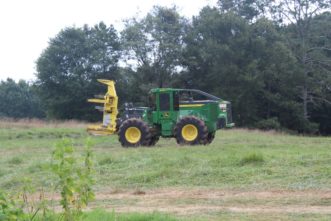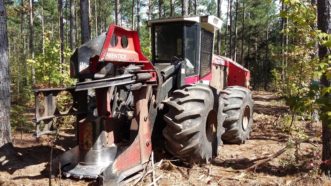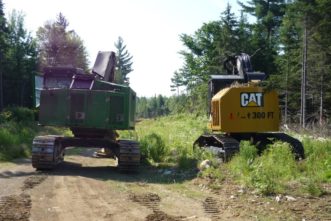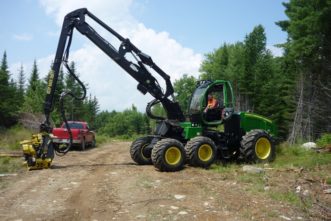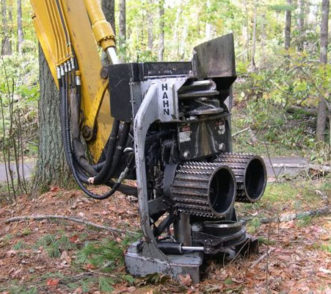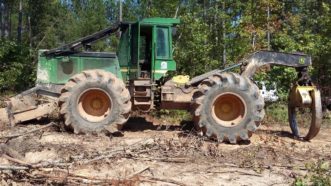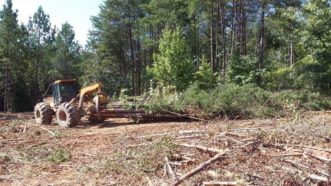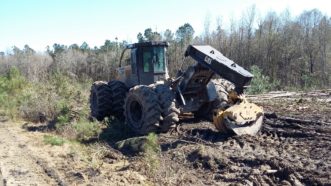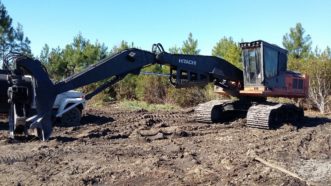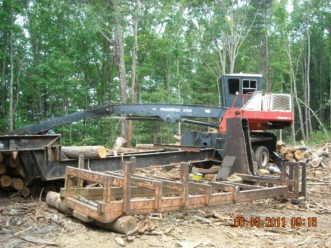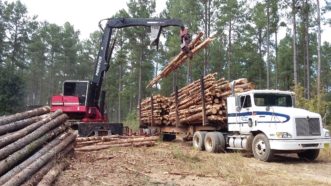Timber harvesting operations are a crucial part of forest management, whether you manage a southern yellow pine plantation or a naturally regenerated hardwood forest. Many of the experienced landowners in SC know about the different types of harvesting equipment used today, as they have seen them in operation on their property. For new and beginning forest landowners, however, it can be difficult to fully understand the breadth of equipment operating in SC and its specific purpose to a timber harvesting operation. To make the transition into forest management and forest operations as easy as possible, our goal with this publication is to highlight the harvesting equipment commonly used in the state and provide a brief description of the purpose and function of the equipment. Additional information on harvesting equipment can be found on the USDA Forest Service Forest Operations Equipment Catalog website.
Timber harvesting equipment can be separated into five categories: felling, primary transport/extraction, processing, loading, and secondary transport/hauling. There are also differences in equipment combinations and the type of equipment used in the Upstate and Coastal Plain areas of SC. In addition to timber harvesting equipment, there also exists a variety of other equipment for site preparation, tree planting, and many other aspects of forest management. A brief review of the literature on many aspects of forest operations in the southern US can be found in the Forest Operations Technology report.2 For this article, we are focusing on fully mechanized harvesting equipment only, and thus will not discuss the use of chainsaws and cable skidders.
Felling Equipment
Rubber-Tired Feller-Buncher (Wheeled Feller-Buncher; Drive-to-Tree Feller-Buncher)
The rubber-tired or drive-to-tree feller-buncher (figure 1) is probably the most common felling machine in the southern US and SC. The name is derived from the function of the machine of cutting and bunching more than one tree. For this, the feller-buncher typically cuts one tree at the time, and then moves the machine, with the tree in its cutting head, to the next tree to accumulate multiple trees in a bunch. The bunch of trees is then laid down on the ground.
This machine sits on four large rubber tires and drives to every single tree that is being cut. The main cutting part of the feller-buncher is the cutting head (figure 2) that consists of two types of metal arms: the accumulator clamp arm and the main clamp arm. The accumulator arm is articulated, meaning that it consists of multiple pieces that are spring-loaded to stay in place. The purpose of this arm is to hold harvested trees in the cutting head while another tree is added to the bunch. Due to the articulated design, this arm can then be moved from underneath the newly cut tree to hold it in place. The main clamp arm typically grabs and holds a tree while it is cut. The cutting is done with a 2-inch thick, constantly rotating saw disk that consists of dozens of cutting teeth.
Rubber-tired feller-bunchers come in different sizes and are developed and built by a series of equipment manufacturers including Tigercat™, Weiler™ (formerly Caterpillar), and John Deere™. The equipment operator can sit more than eight feet above the ground and has only a very limited window to see trees and the surrounding areas. Thus, it is highly recommended to stay at least 300 to 500 feet back from a moving feller-buncher. Never approach a feller-buncher until the saw disk has stopped moving, and the equipment operator has shut down the equipment or acknowledged your presence.
Tracked Feller-Buncher (Swing-to-Tree Feller-Buncher)
The tracked feller-buncher or swing-to-tree feller-buncher (figure 3) is commonly used in the Coastal Plain region of SC. Instead of moving on tires, the tracked feller-buncher has two sets of tracks that it moves on, similar to an excavator. Early models of the tracked feller-buncher were actually excavator bases with a feller-buncher head instead of a bucket. Tracked feller-bunchers continue to develop further and, for more than a decade, have existed as a specialized piece of equipment with a very specific application to the harsh conditions of timber harvesting. One of the major changes compared to an excavator is the reduced length of the overhang behind the machine from about three feet in an excavator to a few inches with a dedicated feller-buncher base. This allows the machine to swing around without damaging trees that are adjacent to the cutting trails. Dedicated feller-buncher bases also come with self-leveling operator cabins that automatically adjust the horizontal positioning of the operator when climbing and operating on slopes. This increases the harvesting efficiency when operating in steep terrain as the operators are able to get a better view of the trees they are felling.
The cutting head of a tracked feller-buncher is similar to the one on a rubber-tired feller-buncher. The difference is, however, that the cutting head is mounted on a 20- to 25-foot boom. This allows the tracked feller-buncher to stay on a skid trail and swing to individual trees that need to be removed, rather than driving to every tree. This can increase harvesting productivity and minimize soil compaction outside of the skid trails. Tracked feller-bunchers are especially useful in areas with sensitive soil conditions, as the weight of the machine is distributed over a larger surface area and thus has a fairly low impact on soil compaction. This type of feller-buncher is also often used when cutting timber in swamps and wet areas with a method called shovel logging.
Tracked feller-bunchers also come in a variety of different sizes (figure 4) and are built by most of the timber harvesting equipment manufacturers. As with the rubber-tired feller-buncher, it is advised to stay at least 300 to 500 feet away from the feller-buncher when it is operating. Due to the spinning saw blade, there is a risk for wood chips and large pieces of wood to be slung off the saw blade across the harvest site.

Figure 3. A purpose-built tracked feller-buncher has much less tail overhang than an excavator does. Wearing a hardhat and high visibility safety vest are good measures of personal protective equipment to improve the chances of being seen in a forest. Image credit: Patrick Hiesl, Clemson University.
Harvester (Processor)
A harvester is a machine that can fell, delimb, and process a tree in the forest into products of different specifications. A processor is a similar machine but typically is not equipped to fell a tree. It delimbs and processes already felled trees, usually at a deck or landing. Often the name harvester and processor are used interchangeably, so it requires additional information to fully understand each machine’s function. Harvesters typically have four to eight wheels depending on their size and are also available as tracked machines for handling different logging conditions. Harvesters originated in Scandinavia and are very common in the Lake States and northeastern US. Very few are in operation in the southern US, mostly due to different market demands for the timber. Recently, some southern mills have conducted trials on using processors at the landing to investigate potential efficiencies.3,4
The harvester felling head is much different from the feller-buncher cutting head. For wheeled harvesters, the felling head is called a dangle-head as it loosely swings during machine movement. The dangle-head on a wheeled harvester is typically mounted on a 30-foot boom to allow for a greater reach into the forest. In contrast to a feller-buncher, a dangle-head harvester (figure 5) does not have the physical power to lift a tree after cutting it, but rather pulls on the butt end of the tree to direct its felling. Instead of a saw disk to fell trees, a harvester head usually uses a chain with cutting teeth, similar to a chainsaw chain. Tracked harvesters commonly use fixed heads (figure 6). The cutting head is mounted and attached to a boom, similar to the tracked feller-buncher. This machine has enough power to lift cut trees straight off the ground. Both cutting heads also consist of feeding rolls and delimbing knives.
Harvesters are manufactured by many different companies, including John Deere™ and Tigercat™; however, the most commonly known harvesters are built by Ponsse™ (yellow color) and Komatsu™ (red color). As with other felling equipment, you are advised to stay far away from the machine until the cutting head has been placed on the ground, and the equipment operator has acknowledged your presence.
Primary Transport/Extraction Equipment
Grapple Skidder
Grapple skidders (figure 7) are the most common primary extraction equipment in the southern US. These machines are generally equipped with four rubber tires, although some larger models have six wheels. The grapple skidder looks similar to a rubber-tired feller-buncher; however, the backside of the machine has a short arch with a large grapple. The purpose of the grapple is to grab and drag a load of trees to the landing for processing. Depending on the size of the skidder and the grapple, one load can consist of multiple trees weighing several tons.
The feller-buncher operator places individual bunches of trees on a skid trail for the grapple skidder operator to drag along the skid trail system to the landing (figure 8). When the feller-buncher and grapple skidder operators work well together, the feller-buncher operator knows the maximum number of trees the grapple skidder can transport on a given site and will adjust the size of a bunch accordingly. Sometimes, the grapple skidder will pick up two bunches at a time to increase its productivity. In swampy and wet conditions, a grapple skidder often has dual tires (figure 9) in the front and back to increase floatation, reducing ground pressure and the risk of soil compaction.
Clambunk Skidder
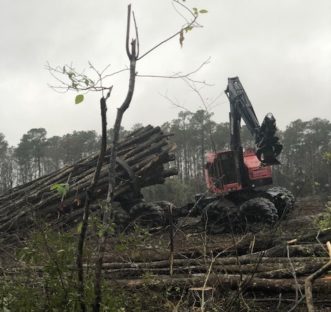
Figure 10. A self-loading clambunk skidder with a crane preparing to drag a bunch of trees. Image credit: Jay Philipps, Resource Management Service.
A clambunk skidder (figure 10) is designed to drag a much larger number of trees than a grapple skidder can. The clambunk skidder typically consists of six or eight sets of dual tires to allow for increased floatation. These skidders are used in areas with wet soil conditions such as swamps. Many of these skidders do not carry a crane with them and have to be loaded by a separate piece of equipment. In many instances, the clambunk skidder is loaded by a shovel machine (similar to an excavator with a grapple) that is used for shovel logging in the swamps in the lower Coastal Plain of SC.
Shovel Machine (Shovel)
A shovel machine, or shovel, is used in shovel logging operations in the swamps and wet areas of the lower Coastal Plain in SC. The machine is a tracked log loader with a grapple mounted to a 20-foot boom (figure 11). Unless built for a specific purpose, most shovel machines are similar to an excavator in appearance. The primary purpose of the shovel is to build skid trails by using cut trees. These trails are called shovel roads (figure 12) and are designed to reduce the ground pressure when skidders move across the road. This prevents skidders from sinking into the wet ground and allows for the harvesting and skidding of timber during wet ground conditions. Shovels are also used to move cut trees across a wet area closer to a shovel road or the landing. The shovel is further used to load trees onto clambunk skidders that have no crane. Since shovel logging is more expensive than other logging techniques, it is only used in circumstances where ground conditions are too wet for any other type of logging operation.
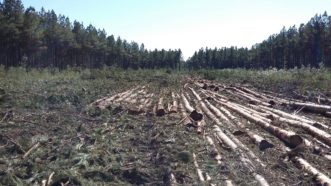
Figure 12. A shovel road is a skid trail lined with a number of trees to improve travel conditions for skidders on sites with wet ground conditions. After the harvest is finished, the trees from the shovel road will be transported to the landing to be processed and sent to the mill. Image credit: Patrick Hiesl, Clemson University.
Forwarder
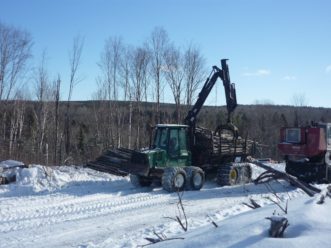
Figure 13. A forwarder moving to the landing site with a load of logs in northern Maine. Image credit: Patrick Hiesl, Clemson University.
Instead of dragging trees on the ground, a forwarder (figure 13) typically transports logs that are already cut to mill specifications. A forwarder consists of one or two bunks in the back of the machine that can hold ten or more tons of logs. Forwarders come in different sizes and have either eight or ten rubber tires. In addition to the bunk, a forwarder also has a crane to lift logs from the ground into the bunk for transportation. Forwarders are most often used in combination with a harvester, but implementations in other harvesting systems are possible. Like the harvester and processor, forwarders are not very common in the southern US.
Processing and Loading Equipment
Tracked Loaders
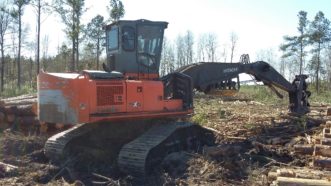
Figure 14. A tracked loader may be used to load log trucks in areas where shovel logging is used for timber harvesting. Image credit: Patrick Hiesl, Clemson University.
In some instances, a tracked loader (figure 14) may be used at the landing to load a truck. A tracked loader is similar to the shovel machine and consists of a tracked base with a crane mounted grapple. Tracked loaders can come in many forms. The operator cabin can be fixed or adjustable in height to provide the operator with the best possible view for efficiently loading a log truck. Since many timber harvesting operations in southern yellow pine plantations use a trailer-mounted loader with a pull-through delimber, a tracked loader is not a common sight when harvesting pine stands. Tracked loaders may be more common in areas where shovel logging takes place.
Truck-Mounted Loaders

Figure 15. A truck-mounted loader using a three-axle truck base. Image credit: Patrick Hiesl, Clemson University.
Truck-mounted loaders typically consist of a three-axle truck with a loader crane mounted on top (figure 15). These loaders often times can move independently from one harvest site to another. In many northern states, truck-mounted loaders are built on top of older trucks that are no longer licensed to drive on paved roads. Such loaders either move on private roads only or will be transported on the low-bed trailer of a truck. While truck-mounted loaders are common in the northern US, its use in southern yellow pine forestry is limited due to the use of trailer-mounted loaders and pull through delimbers. However, low volume timber harvesting operations using chainsaws and skidders, especially in the mountainous region of the state, often use truck-mounted loaders to load log trucks. Truck-mounted loaders are typically shorter in length than a trailer-mounted loader and thus can be used on sites with small landings.
Trailer-Mounted Loader and Pull-Through Delimber
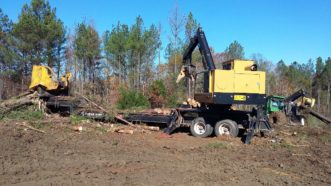
Figure 16. A trailer-mounted loader (right) with a pull-through delimber (left). Image credit: Patrick Hiesl, Clemson University.
The most common equipment situated at the loading dock in the southern US and SC is the trailer-mounted loader with a pull-through delimber (figure 16). A loader is a machine that is attached to a trailer and consists of a boom and grapple. The loader can rotate 360 degrees to pick up trees that the grapple skidder or other primary extraction equipment dropped within its reach. Typically, the loader will grab one tree at a time and lift it to the pull-through delimber mounted to the trailer on the opposite end. During a first thinning, when trees are smaller, multiple trees may be delimbed at the same time. A pull-through delimber consists of a set of delimbing knives that wrap around the stem of a tree. When the knives are closed tightly around the tree, the loader will pull the tree through the delimbing knives, removing the branches. Once the branches are gone, a top saw using a chain with cutting teeth will cut the top of the tree off or cut to a specific top diameter limit. The movements of the delimbing knives and the top saw are all coordinated and controlled by the loader operator.
Often the loader operator estimates the total length of the tree before cutting the top off. Other times, especially when sawlogs need to be cut out of a tree, a slasher saw (buck saw) is used to cut very specific lengths of logs. A slasher saw (figure 17) is typically set on the ground next to the loader and connected to the loader’s hydraulic system. Once trees are processed into logs, the logs are sorted and stacked in piles of different products waiting for transport by truck to product-specific mills (figure 18). Typically, only one product, such as pulpwood or chip-n-saw, is placed on a truck load. This practice is required, as most mills only buy one specific product. Due to this, you may see a variety of product piles or stacks around a landing area, especially when working in a mixed-wood stand consisting of softwood and hardwood species. Each product is typically sent to a different mill for further processing.
Delimbing Gate
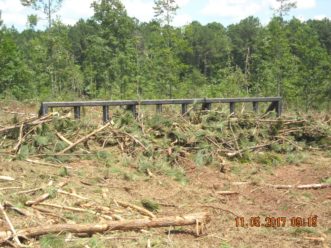
Figure 19. When harvesting southern yellow pine, a delimbing gate is typically set up close to the landing. Image credit: Joseph Conrad, University of Georgia.
To reduce the number of branches collecting around the pull-through delimber, and to keep the majority of branches away from the landing, a delimbing gate near the landing is often used when harvesting southern yellow pine. The delimbing gate, a large metal frame with cross beams (figure 19), is partially buried in the ground and often anchored between two trees. When a grapple skidder drags a bunch of southern yellow pine trees to the landing, it will typically stop at the delimbing gate and back-up the bunch of trees into the gate to break off the majority of branches. Most branches are completely broken off or leave stubs of around eighteen inches or less in length. Afterward, the grapple skidder will drag the bunch of trees to the landing, where they will be processed by the loader and pull-through delimber. Due to the shorter length of braches on the trees, the waste collecting around the pull-through delimber is minimal and thus does not need to be removed as often. While the delimbing gate works well with southern yellow pine, it is not as effective with other softwood and hardwood species. Thus, a delimbing gate will not be present at every harvest site. Also, the delimbing gate can cause damage to the hydraulic system of skidders that were not designed for this sort of action.
Secondary Transport/Hauling Equipment
Log Trucks
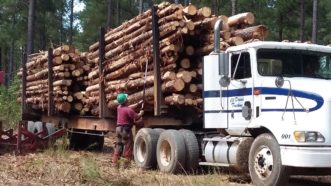
Figure 20. A conventional truck with a straight frame trailer. The bolsters of this trailer are set up to hold two separate loads of shorter cut-to-length wood. Image credit: Patrick Hiesl, Clemson University.
Transporting the different wood products from a landing to a mill is an essential function of timber harvesting operations. It is the final step that generates a payment from the mill to the timber buyer or landowner. Most often, a single product such as pulpwood or chip-n-saw will be transported to a mill using a log truck. Log trucks can come in many different forms and shapes and can include conventional trucks with long hoods, cabover trucks where the driver cabin is situated on top of the engine, and even conventional trucks with sleeper cabs (extended backside of driver cabin). Typically, a truck pulls a straight-frame log-trailer that consists of multiple bolsters to keep the loaded logs within the dimensions of the trailer (figure 20). Many other trailer versions exist for specialized uses such as transporting wood chips, whole trees, and shorter cut-to-length wood. When you observe the loading of a log-trailer, you may see that the trailer is not filled up to the very top. This is due to the weight limitations that exist for log trucks on the roads of SC (or any other state). The loader operator will gauge the weight put on the log truck based on experience or possibly scales that are set up at the landing. You may also notice that the loaded log truck is leaving the landing only to drive a few yards before the truck stops again. Before a log truck can drive away from the landing, the logs that are loaded onto the trailer need to be secured with at least two straps. The truck driver will move the truck and trailer out of the way before securing the load so that the next log truck can proceed to the landing.
As with all timber harvesting equipment, you have to be cautious when approaching a log truck. The driver will not see you if you are immediately in front or at the rear of the truck. Moving around a log truck is not advisable unless the logs have been secured with two straps, as there is a risk that individual logs can fall off the trailer. You also need to stay away from the log trailer during loading. Several lives have been lost due to the loader operator not seeing a person and hitting them with a moving log. In general, it is best not to approach a log truck until the driver and the loader operator have acknowledged you.
While transporting logs with a log truck is the most common system in the southern US and SC, other means of transporting logs exist. In the early days of timber harvesting, the railroad system was used extensively for transporting logs. Today, the railroad is still used to transport logs over a great distance, but the use is not as prevalent as trucking. Moving logs on waterways is also common in areas with larger river systems such as the Mississippi River. Typically, wood is floated on a series of barges that can hold several truckloads at once.
Summary
Logging, or timber harvesting, is a central part of forest management, and many different pieces of equipment can be involved in a single timber harvesting operation. In this publication, we introduced the most common types of harvesting equipment that can be found in SC and surrounding areas. We have focused on fully mechanized equipment, meaning that no person performs any major part of their work outside of the safety of an operator cab. Several other types of harvesting systems exist in other parts of the US that rely heavily on manual labor for the use of chainsaws and cable skidders. These systems also exist in SC but are not as commercially significant as the more mechanized harvesting systems. Nonetheless, all systems have a role in forest management and should be considered based on landowner goals. Additional information about timber harvesting equipment can be found in the references cited section below, but also by browsing the Internet.
References Cited
- USDA Forest Service. Forest Operations Equipment Catalog. 2020 [accessed 2020 Jun 4]. https://www.fs.fed.us/forestmanagement/equipment-catalog/index.shtml.
- Rummer B. Forest Operations Technology. In: Southern Forest Resource Assessment. General Technical Report SRS-53. Asheville, NC: USDA Forest Service, Southern Research Station; 2002. p. 341–354.
- Grove PM, Conrad JL, Dahlen J. Volume and value recovery comparison of processor and conventional systems in pine stands of the US South. International Journal of Forest Engineering. 2019;31(1):29–36.
- Conrad JL, Dahlen J. Productivity and cost of processors in whole-tree harvesting systems in southern pine stands. Forest Science. 2019;65(6):767–775. doi:10.1093/forsci/fxz036.

